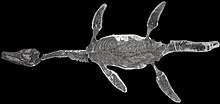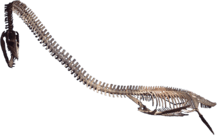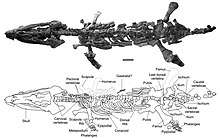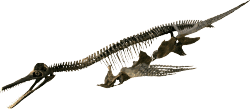Eromangasaurus
Eromangasaurus is an extinct genus of elasmosaurid known from northern Queensland of Australia.[1]
| Eromangasaurus | |
|---|---|
 | |
| Life reconstruction | |
| Scientific classification | |
| Kingdom: | Animalia |
| Phylum: | Chordata |
| Class: | Reptilia |
| Superorder: | †Sauropterygia |
| Order: | †Plesiosauria |
| Family: | †Elasmosauridae |
| Genus: | †Eromangasaurus Kear, 2005 |
| Species: | †E. australis |
| Binomial name | |
| †Eromangasaurus australis (Sachs, 2005 [originally Tuarangisaurus]) | |
| Synonyms | |
| |
Description
Eromangasaurus is known from the holotype QM F11050, a nearly complete but badly crushed skull and mandible. It was collected in Maxwelton, from the Toolebuc Formation of the Eromanga Basin, dating to the late Albian stage of the Early Cretaceous, about 103 million years ago.[1] Sven Sachs mentioned some referred material from the same locality as the holotype, QM F12216-19, an anterior cervical vertebra and QM F12217&2, associated posterior cervical vertebrae.[2]
Etymology
Eromangasaurus was first named by Benjamin P. Kear in 2005 and the type species is Eromangasaurus australis. Benjamin P. Kear originally named QM F11050 as Eromangasaurus carinognathus.[1] However, earlier in 2005, Sven Sachs named a second species of Tuarangisaurus, Tuarangisaurus australis, on the basis of the same specimen and some referred material.[2]
This nominal has priority over E. carinognathus, and therefore the latter is a junior synonym of T. australis. Later studies of the holotype by Kear pointed out that this species is distinct enough from the type species of Tuarangisaurus to be placed in its own genus. Eromangasaurus was the only available name for the new combination Eromangasaurus australis.[3] E. australis is widely accepted today as the correct name for QM F11050.[4][5]
The generic name is derived from Eromanga, in reference to the Eromanga Basin in which the holotype was found, and saurus, Greek for "lizard". The specific name is named after Australia, in which the holotype was found.[1]
References
- Benjamin P. Kear (2005). "A new elasmosaurid plesiosaur from the Lower Cretaceous of Queensland, Australia". Journal of Vertebrate Paleontology. 25 (4): 792–805. doi:10.1671/0272-4634(2005)025[0792:ANEPFT]2.0.CO;2.CS1 maint: uses authors parameter (link)
- Sven Sachs (2005). "Tuarangisaurus australis sp. nov. (Plesiosauria: Elasmosauridae) from the Lower Cretaceous of northeastern Queensland, with additional notes on the phylogeny of the Elasmosauridae" (PDF). Memoirs of the Queensland Museum. 50: 425–440. Archived from the original (PDF) on 2011-09-28.CS1 maint: uses authors parameter (link)
- Benjamin P. Kear (2007). "Taxonomic clarification of the Australian elasmosaurid genus Eromangasaurus, with reference to other austral elasmosaur taxa". Journal of Vertebrate Paleontology. 27 (1): 241–246. doi:10.1671/0272-4634(2007)27[241:TCOTAE]2.0.CO;2.CS1 maint: uses authors parameter (link)
- Peggy Vincent, Nathalie Bardet, Xabier Pereda Suberbiola, Baâdi Bouya, Mbarek Amaghzaz and Saïd Meslouh (2011). "Zarafasaura oceanis, a new elasmosaurid (Reptilia: Sauropterygia) from the Maastrichtian Phosphates of Morocco and the palaeobiogeography of latest Cretaceous plesiosaurs". Gondwana Research. 19 (4): 1062–1073. doi:10.1016/j.gr.2010.10.005.CS1 maint: uses authors parameter (link)
- Hilary F. Ketchum and Roger B. J. Benson (2011). "A new pliosaurid (Sauropterygia, Plesiosauria) from the Oxford Clay Formation (Middle Jurassic, Callovian) of England: evidence for a gracile, longirostrine grade of Early-Middle Jurassic pliosaurids". Special Papers in Palaeontology. 86: 109–129. doi:10.1111/j.1475-4983.2011.01083.x (inactive 2020-01-22).CS1 maint: uses authors parameter (link)




